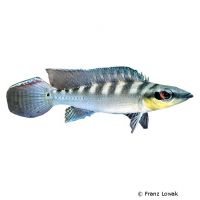Regan's Pike Cichlid (Crenicichla regani)
| Regan's Pike Cichlid Crenicichla regani | |
|---|---|
| Name | Regan's Pike Cichlid |
| Name Lat. | Crenicichla regani |
| Family | Cichlids |
| Family lat. | Cichlidae |
| Order | Cichlids |
| Order lat. | Cichliformes |
| Origin | Brazil |
| Habitat | Streams, tributaries |
| Diet | Carnivore |
| pH | 6.0-7.0 |
| Behavior | Semi-aggressive |
| Keeping | Individual, pair |
| Care Level | Moderate |
| Reproduction | Cave spawner |
| Breeding | Difficult |
| Life Span | 5-8 years |
| Protection | No |
| Metric Units | |
| Size | 8-10 cm |
| Temperature | 24-27 °C |
| Hardness | 2-10 °dH |
| Aquarium | ~ 200 l |
| US Units | |
| Size | 3-4" |
| Temperature | 75-81 °F |
| Hardness | 36-178 ppm |
| Aquarium | ~ 50 gal |
Distribution and habitat
The Regans crested cichlids are widespread in Brazil, in the Amazon River basin. They live in still water of rivers with sandy bottoms, dead wood, aquatic plants and overhanging riparian vegetation. In their large range, some local color forms have evolved.
Maintenance
The aquarium should have a robust border planting, with caves, stones and roots, which provide shelters and hiding places and sufficient free swimming space. A deep substrate of sand or fine gravel, suitable for digging, covered with some foliage (e.g. sea almond tree, beech), some shaded light (floating plants) and a weak current is ideal.
No ammonia, ammonium and nitrite should be detectable, the nitrate value should not exceed 100 mg/l. To ensure the water quality and oxygen content, a filter and heater adapted to the aquarium size is required, as well as lighting for the species-appropriate day-night rhythm of the animals.
Diet
They are lurking hunters. The food supply consists of live and frozen food. For a balanced diet, according to their size, feed once a day with Tubifex, mosquito larvae, krill, shrimp, earthworms, crab and fish meat, etc. (live or frozen). Dry food (pellets, granules, etc.) is rarely accepted.
Only feed as much as will be eaten within a few minutes. Regular and varied feeding promotes health and increases resistance.
Behaviour and compatibility
They are intraspecific and also incompatible with other fish. Especially at spawning time, the territory is fiercely defended. They should be kept singly or in pairs. Keeping several pairs is only recommended in a larger and richly structured tank. Socialization is only possible with larger and robust fish, too small fish are considered prey.
Basically, only compatible fish species with similar demands on water quality and water temperature may be socialized.
Sex dimorphism
The males are elongated and often inconspicuously grayish in color. The somewhat smaller females are more intensely colored, have a reddish belly and eye spots on the dorsal fin.
Reproduction and breeding
They are cave breeders and usually attach the spawn to the cave ceiling or walls. The female does the brood care, while the male defends the brood cave in a wide radius. The fry hatch after 2-3 days, swim free after another 4 days and are carefully guarded by the parents for some time.
Fry must be fed several times a day with special rearing food (Artemia nauplii). In community tanks breeding is hardly possible, because the fry are easy prey.
Important
They swim a lot, are very fast and hunt even at night. Anything living, up to half their own size, is considered food
The well-being of the fish should be checked regularly. Temperature should be checked daily, pH, hardness and nitrate levels at least every 14 days. Regular partial water changes are recommended, even if the contaminant level has not yet reached the upper limit. Sudden changes in water quality should be avoided. Newly introduced fish must be accustomed slowly to the water in the aquarium.
Further literature can be found in your pet store.
References
Text: Werner Winter; Image: Franz Lowak
Source: BMELV (1998): Tierschutzgutachten - Haltung von Zierfischen (Süßwasser); BAENSCH & RIEHL (2004): Aquarien Atlas Bd. 4, Mergus Verlag; ENGELMANN (2005): Zootierhaltung - Tiere in menschlicher Obhut: Fische, Verlag Harri Deutsch
- Gemäß § 21 Abs. 5 Tierschutzgesetz idgF
